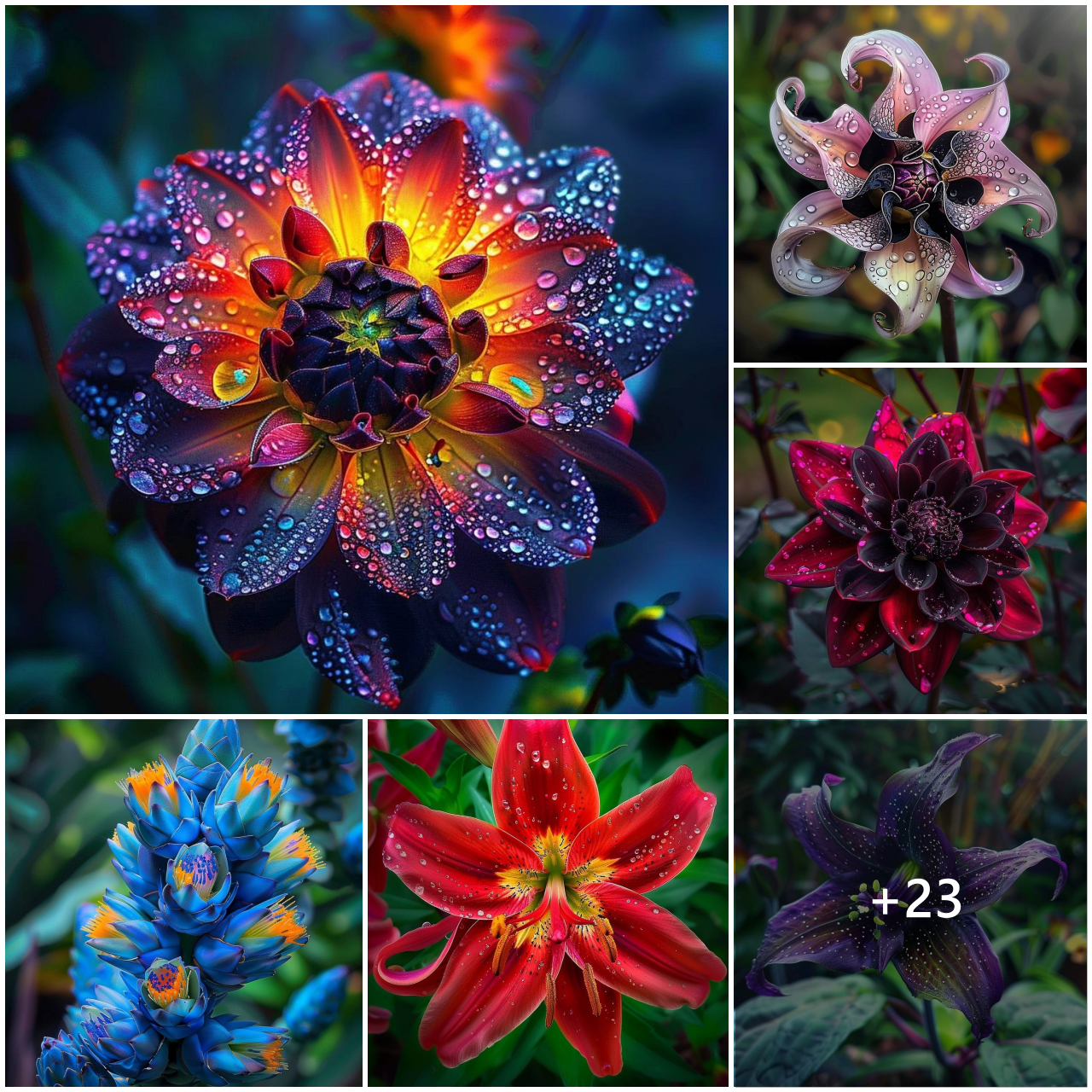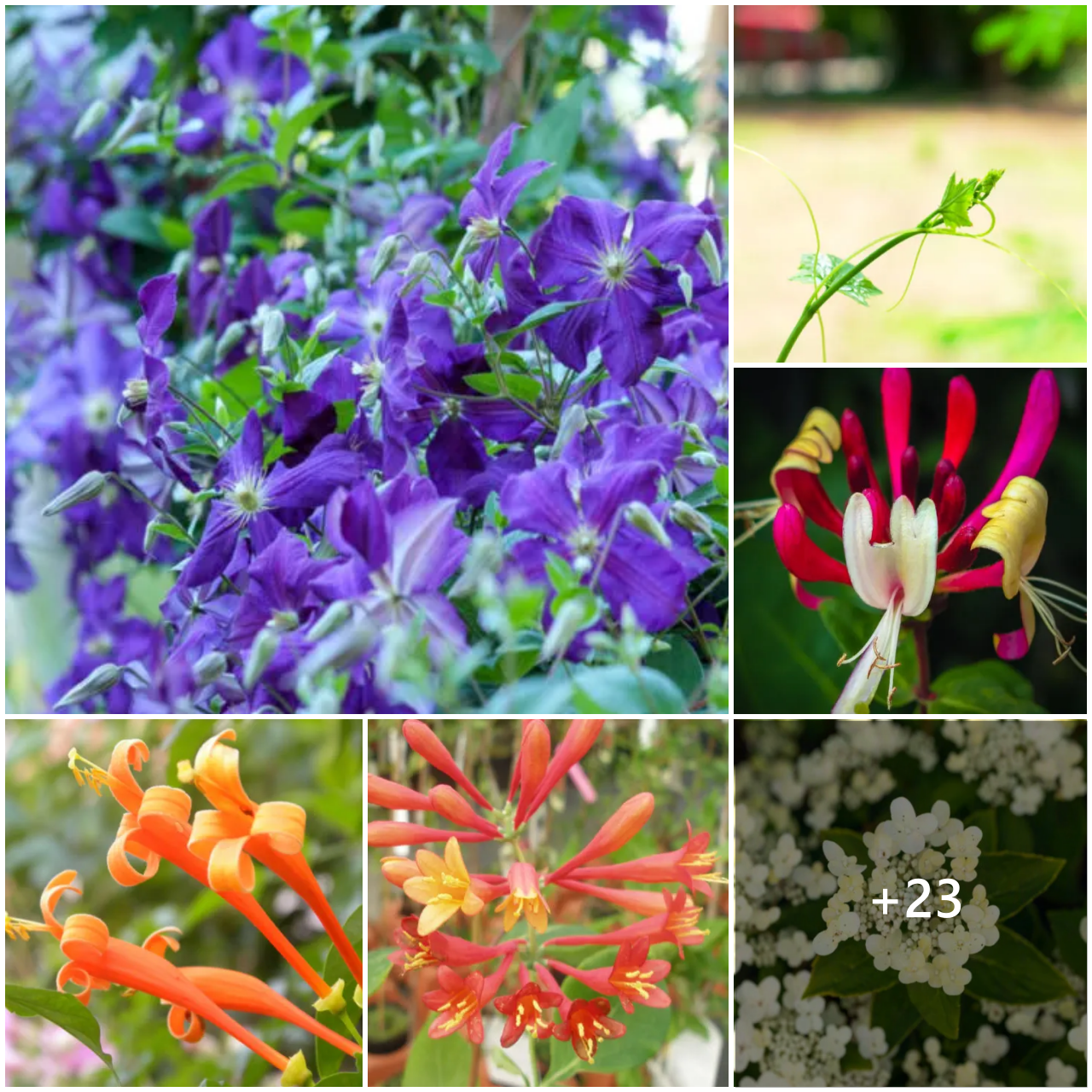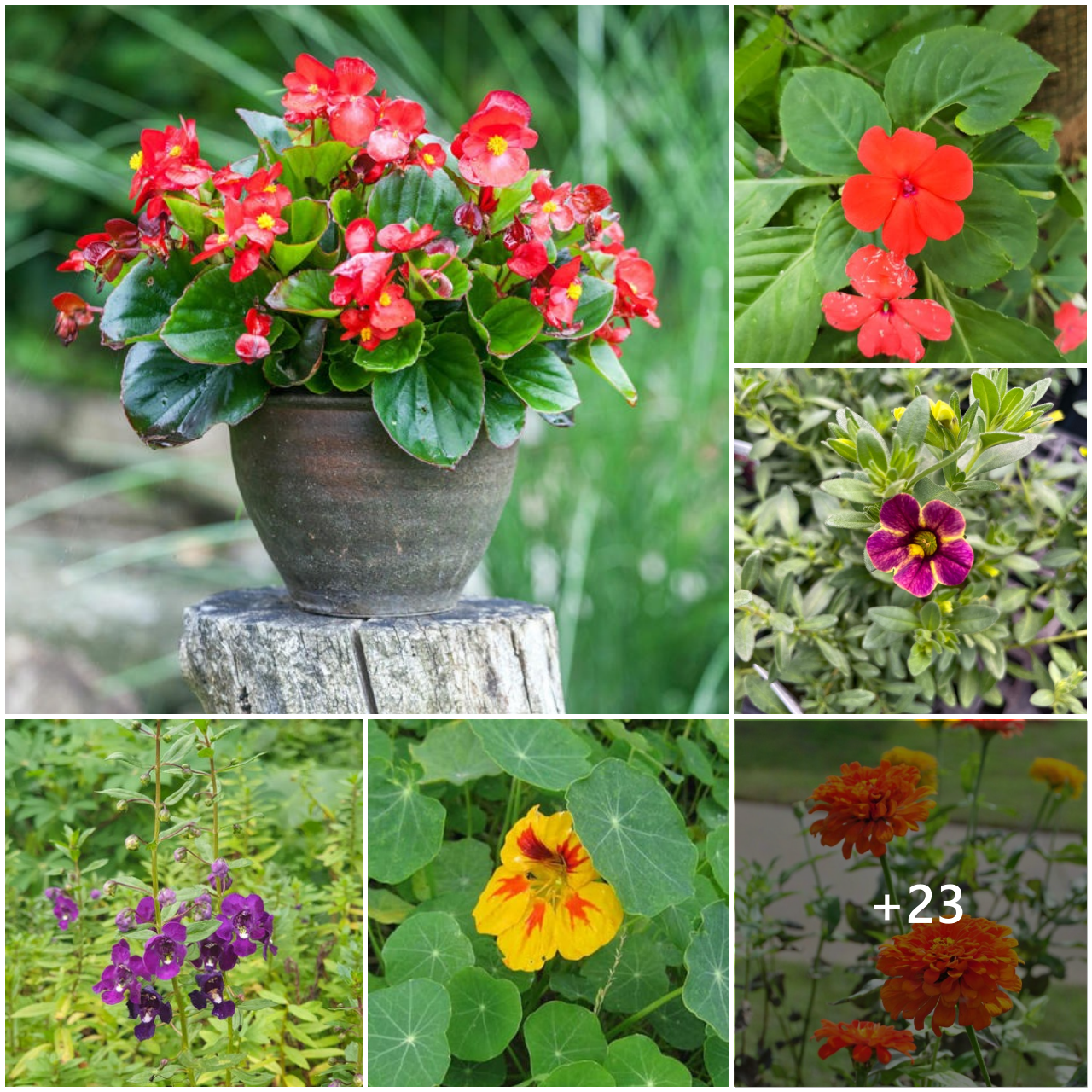The common Hollyhock (Alcea rosea) has skyward stems smothered in giant 5-inch hibiscus-like blossoms that carry a whimsical zeal of times past.
Beyond the impressive dramatic height of 5 to 12 feet is Hollyhock’s magical color spectrum.
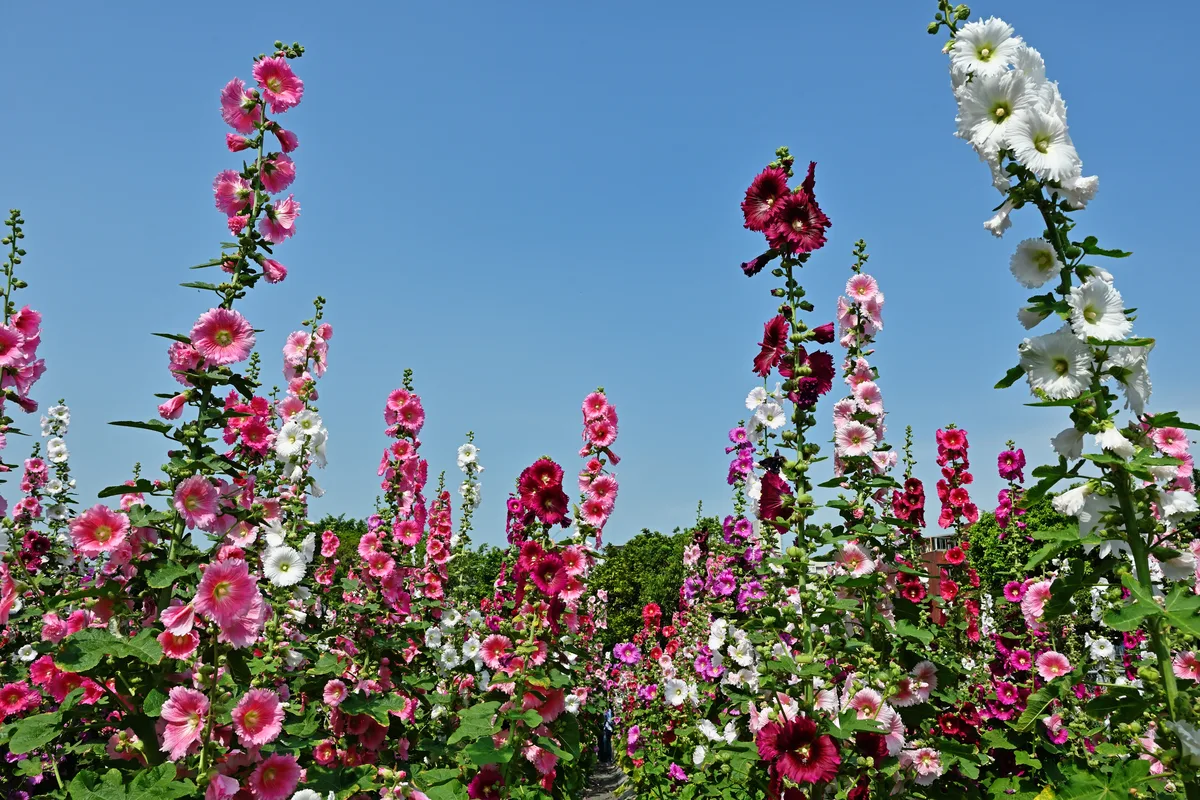
Summer blossoms are singles or doubles and may be variegated, striped, or solid, often with bold contrasting centers.
Of boldest reds, deepest purples, brightest whites, peaches, creams, corals, and pinks, there is a Hollyhock to match any garden theme.
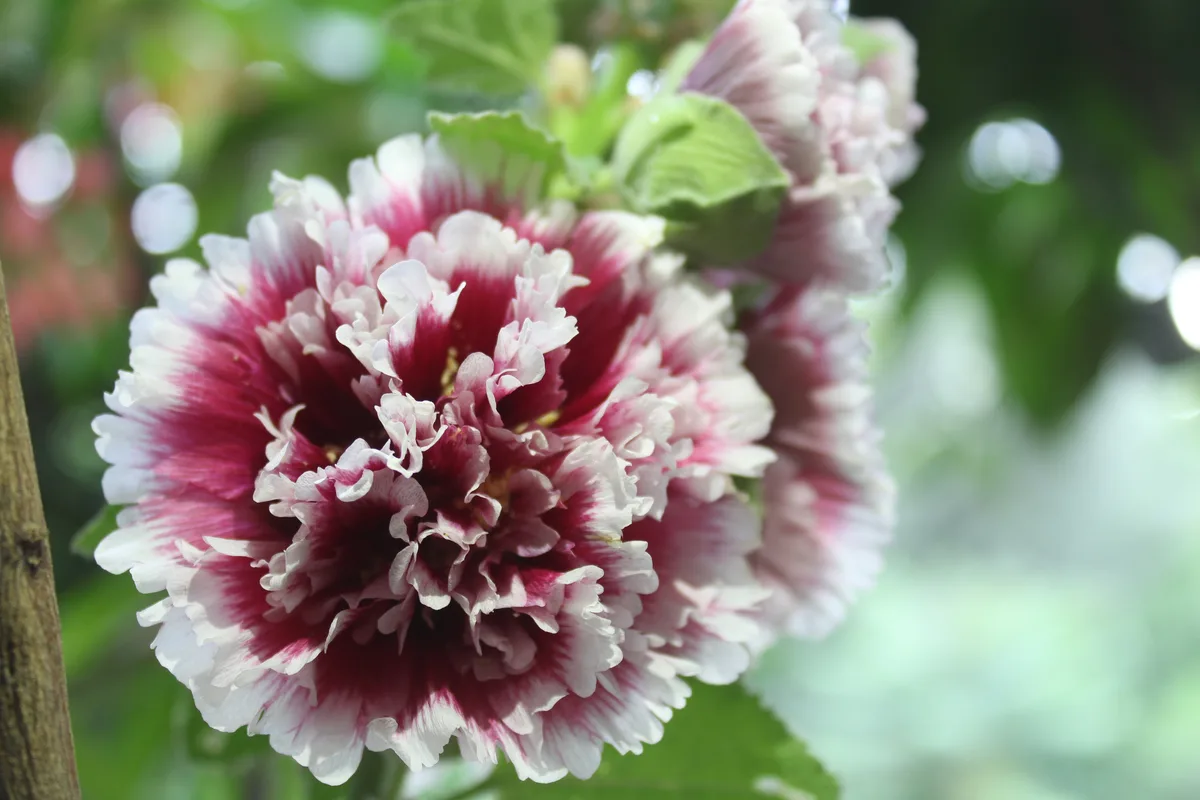
Tolerant of most garden situations, full sun without overly damp winter conditions is heavenly for Hollyhocks.
These herbaceous biennials have a two-year lifecycle, with a mounding rosette of pretty palmate leaves in the first year, followed by flowering seed-producing spires in the second year.
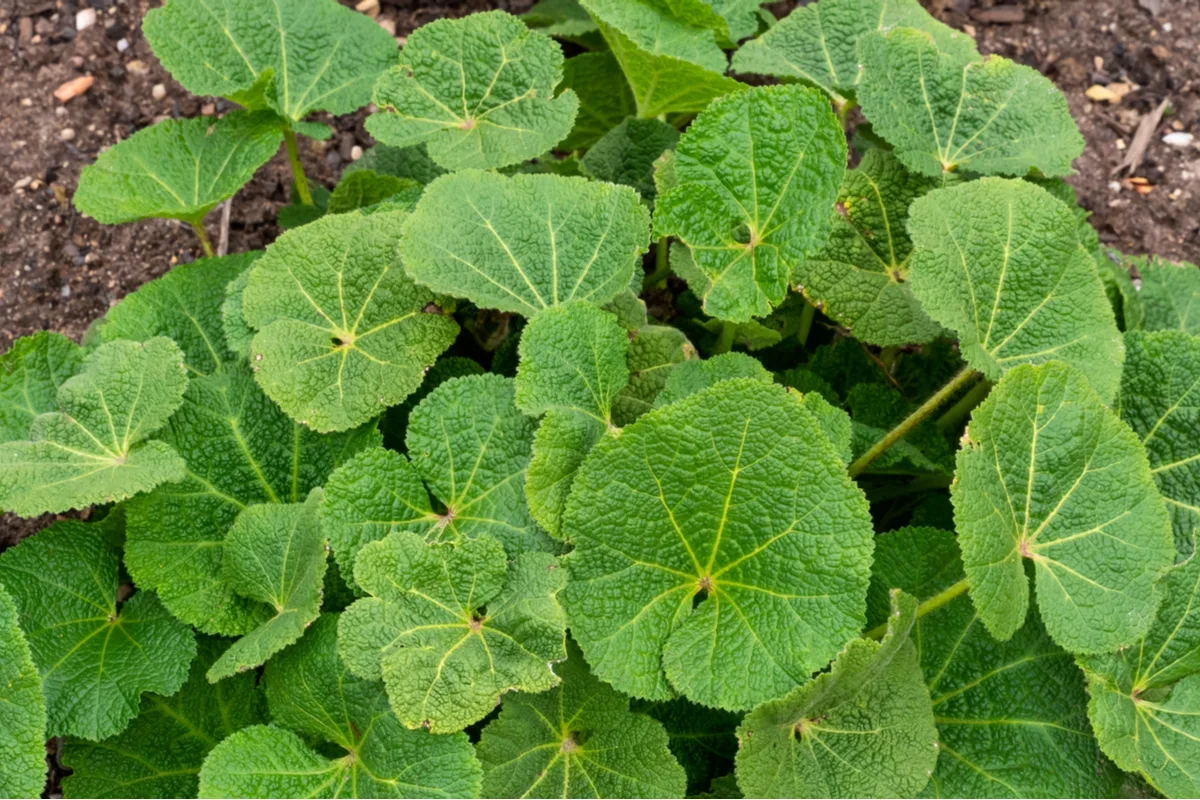
Unlike many upright biennials and perennials that are toxic including foxglove, delphinium, and monkshood, Hollyhock is entirely edible and even has medicinal benefits.
Not just for tea, Hollyhocks provide a host habitat and nectar for butterflies, and they attract birds and bees.
Here are our best tips for heavenly hollyhock blooms.
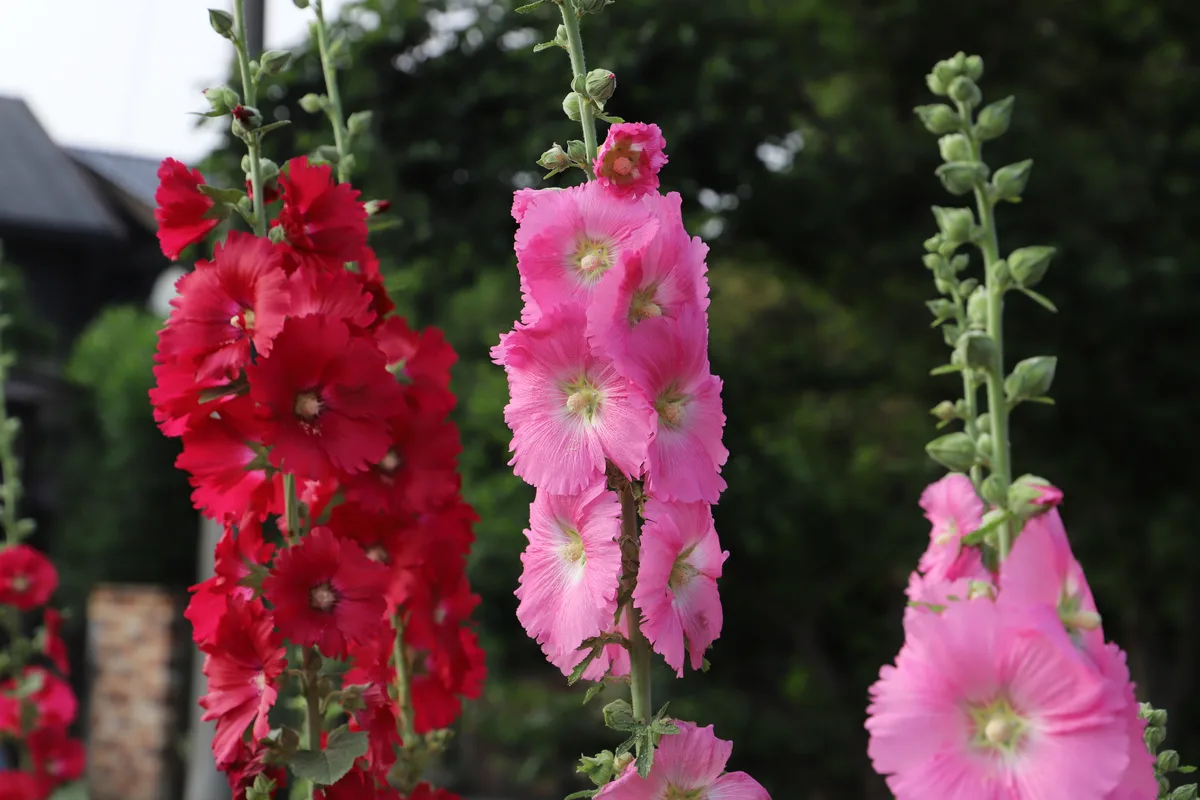
Hollyhocks are extravagantly adaptable and thrive in zones 2 to 10.
Not too wet and not too dry are the preferred climate conditions for Hollyhocks.
Deep soils that are consistently moist in the top 5 inches are the goal.
However, soggy conditions in winter or high humidity may promote a fungal disease known as rust.
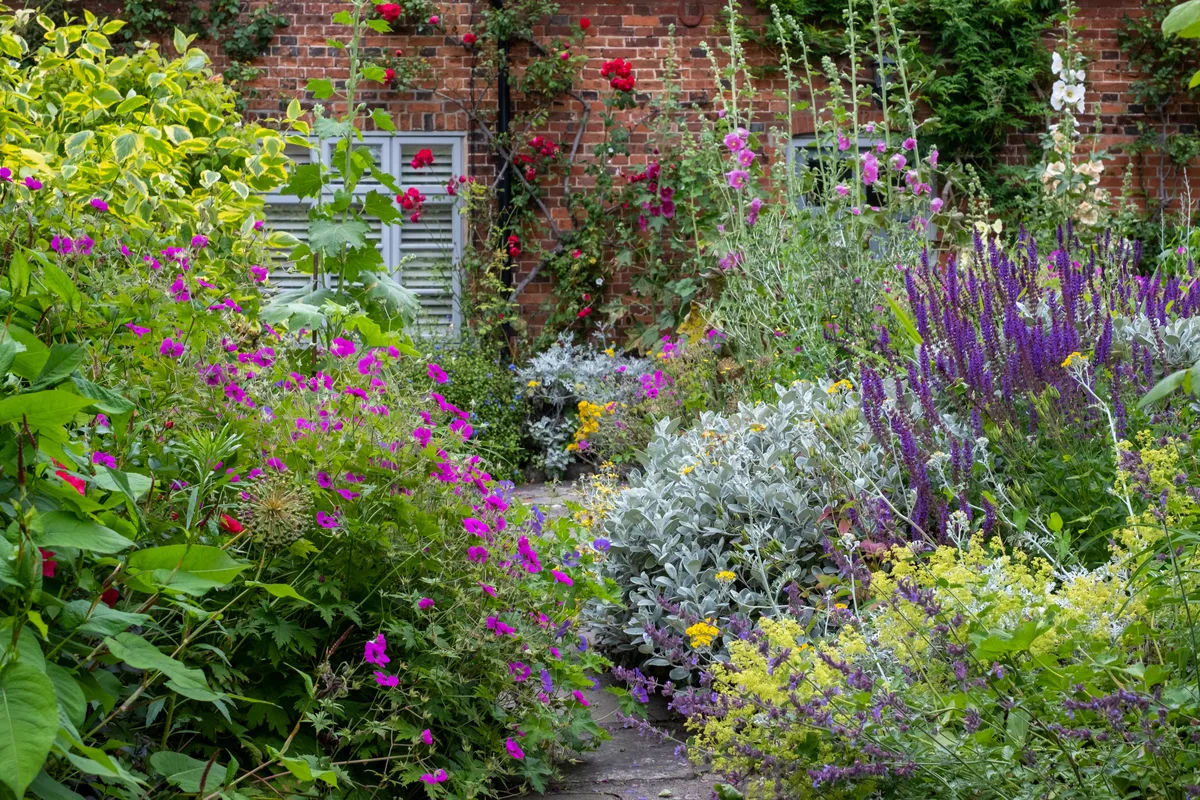
A significantly tall plant, some Hollyhocks can reach 5 to 12 feet tall! The back of the border is Hollyhock’s preferred place.
In places with a lot of wind, consider sheltering tall Hollyhock or provide some support with fences, stakes, or other structures.
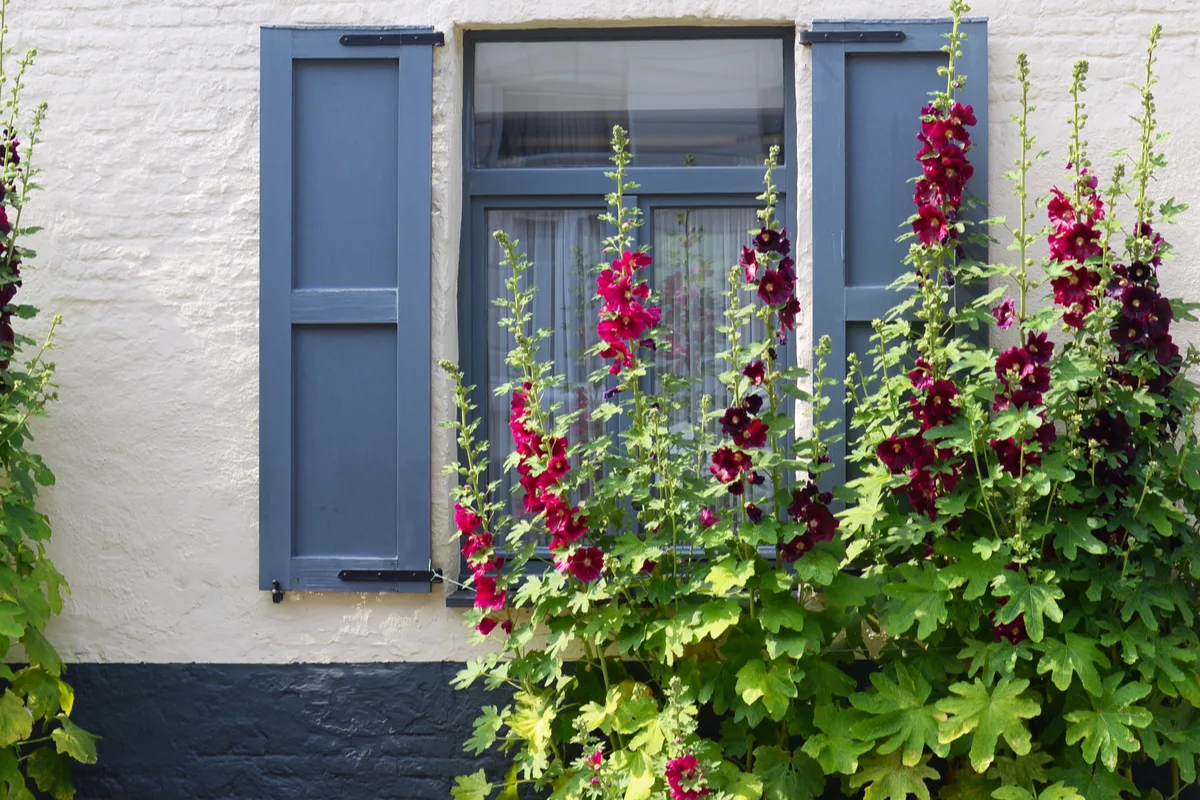
Hollyhocks are a host to young butterflies, also known as caterpillars, who may cause unsightly damage to Hollyhock’s palmate leaves. Plant shorter Hollyhock friends in front to camouflage this plant’s useful quality.
Hollyhock’s height and magnificent heirloom heritage make them a go-to for Cottage Gardens.
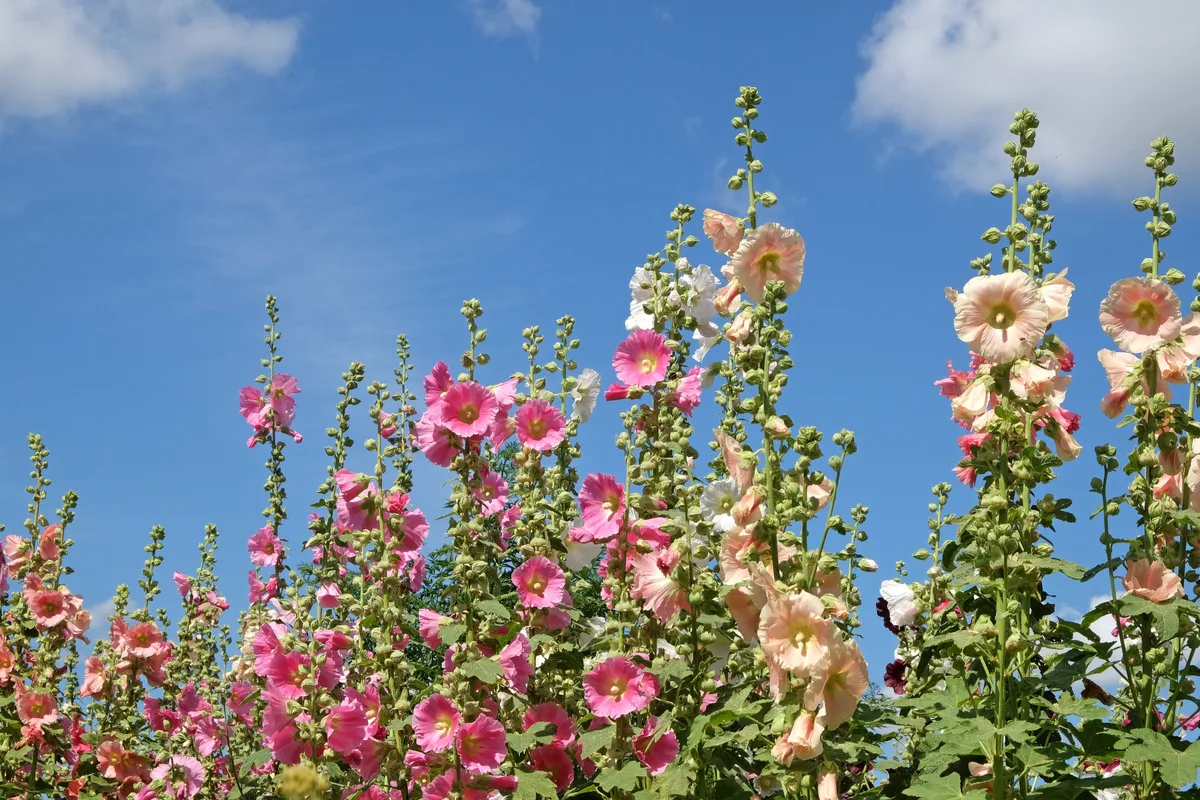
Well-draining deep soils in full sun are perfect for Hollyhock.
They will tolerate partial shade, but their bloom may not be as spectacular.
In areas of high humidity or excessive moisture, well-spaced Hollyhocks in full sun will thwart fungal diseases such as rust.
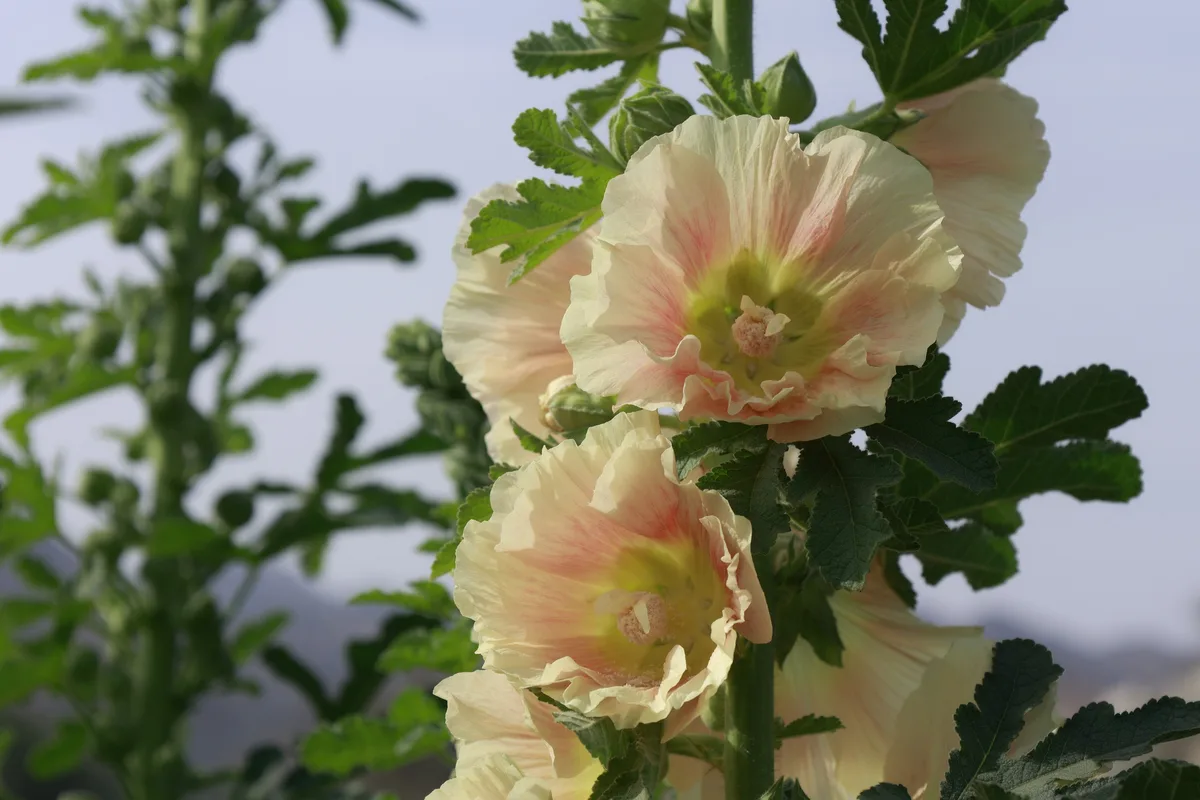
However, in hot, dry areas of the country, a little shady shelter may provide extra moisture for Hollyhocks.
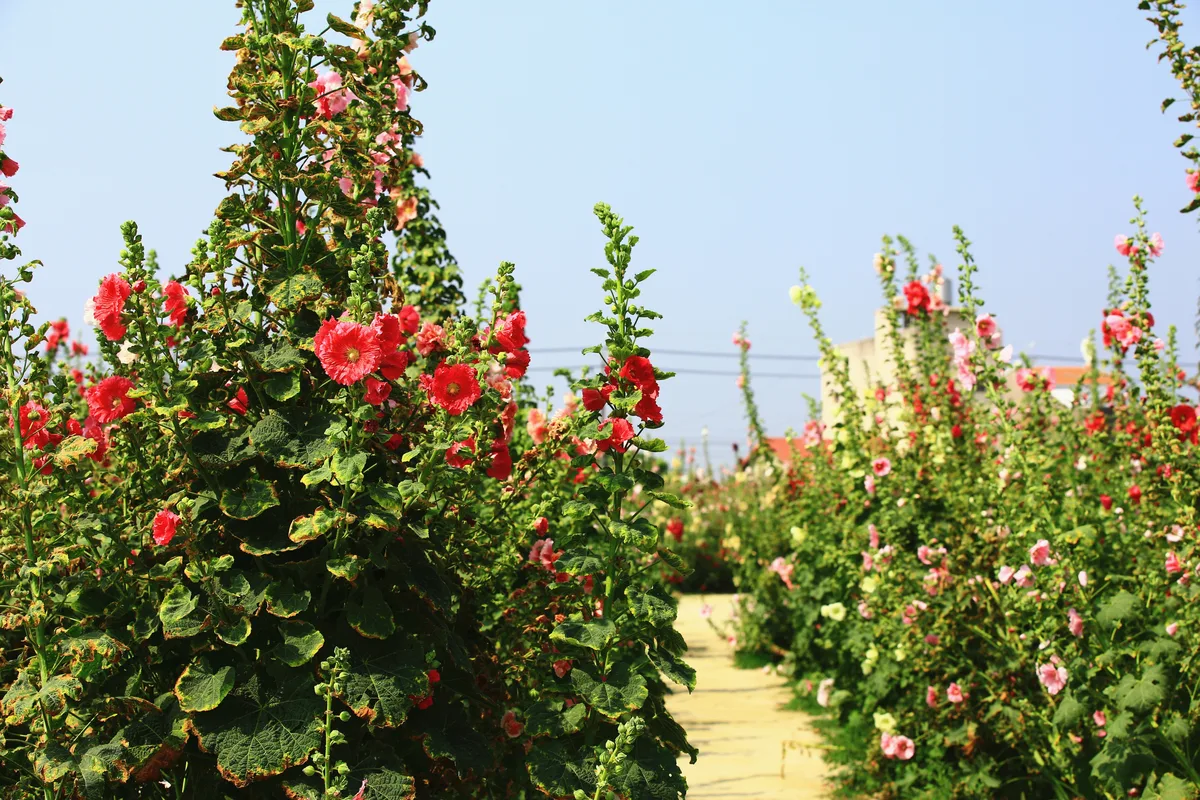
Hollyhocks would be considered heavy feeders and love moist rich soils.
They do grow in almost any type of soil but well-draining, deep, rich soil will give you the best results.
Amend soil with organic matter such as well-rotted manure or compost to create ideal conditions for your Hollyhocks.
Top dress or mulch with compost or organic matter but take care to ensure excellent air circulation to minimize disease.
Hollyhocks with Contrasting Centers
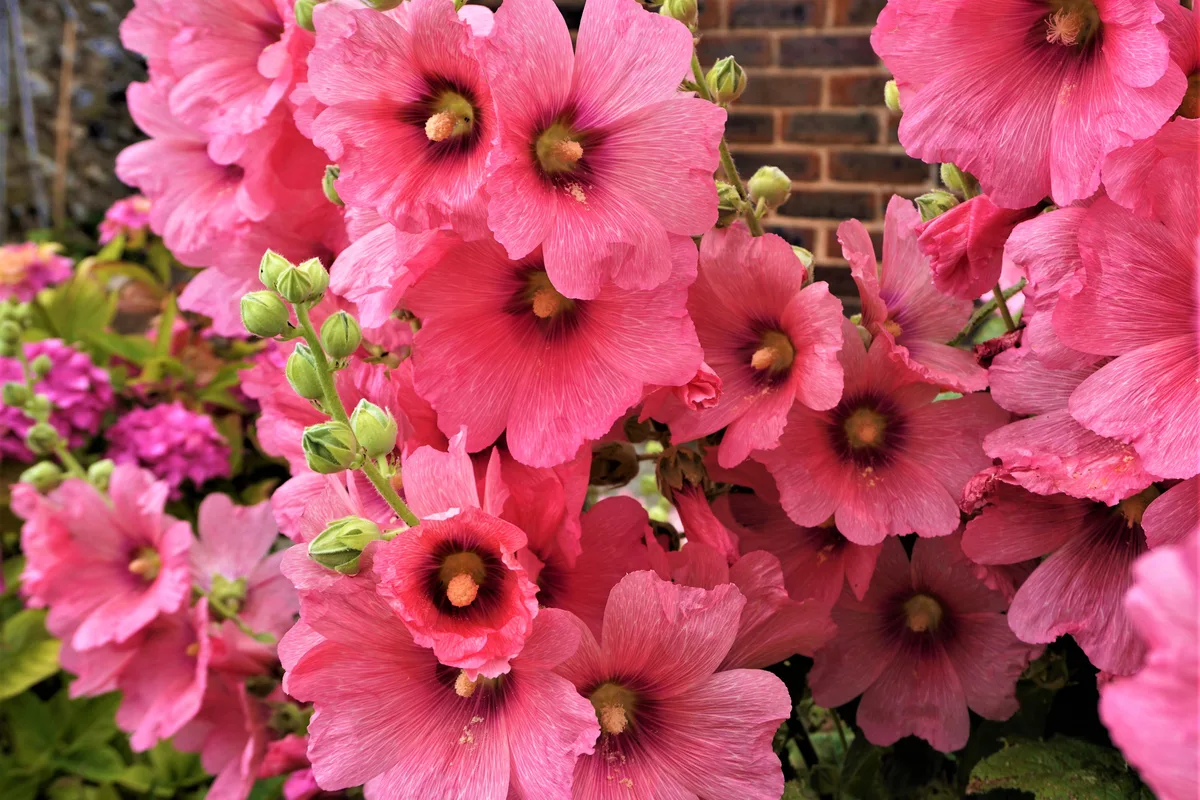
The Halo series has elegant contrasting and complementary centers. They produce bushy, 5 to 8 feet multistem plants in shades of apricot, cherry, cream, pink, red, and white. The halo series is notable for being rust-resistant.
Hollyhocks with Double Flowers
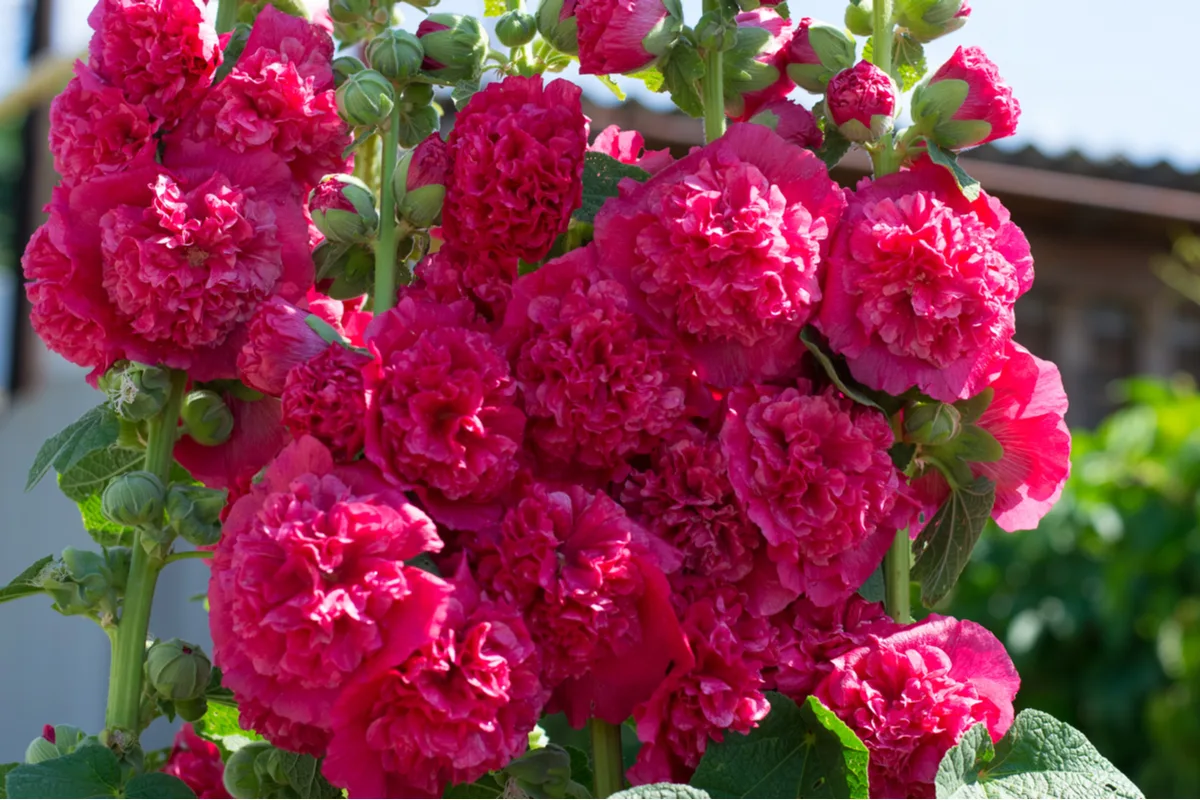
Chater’s, Summer Carnival, and Spring Celebrities are double Hollyhock varieties with stacks and stacks of ruffled, giant carnation-like blooms in all your favorite Hollyhock shades.
Deepest of Red Hollyhocks
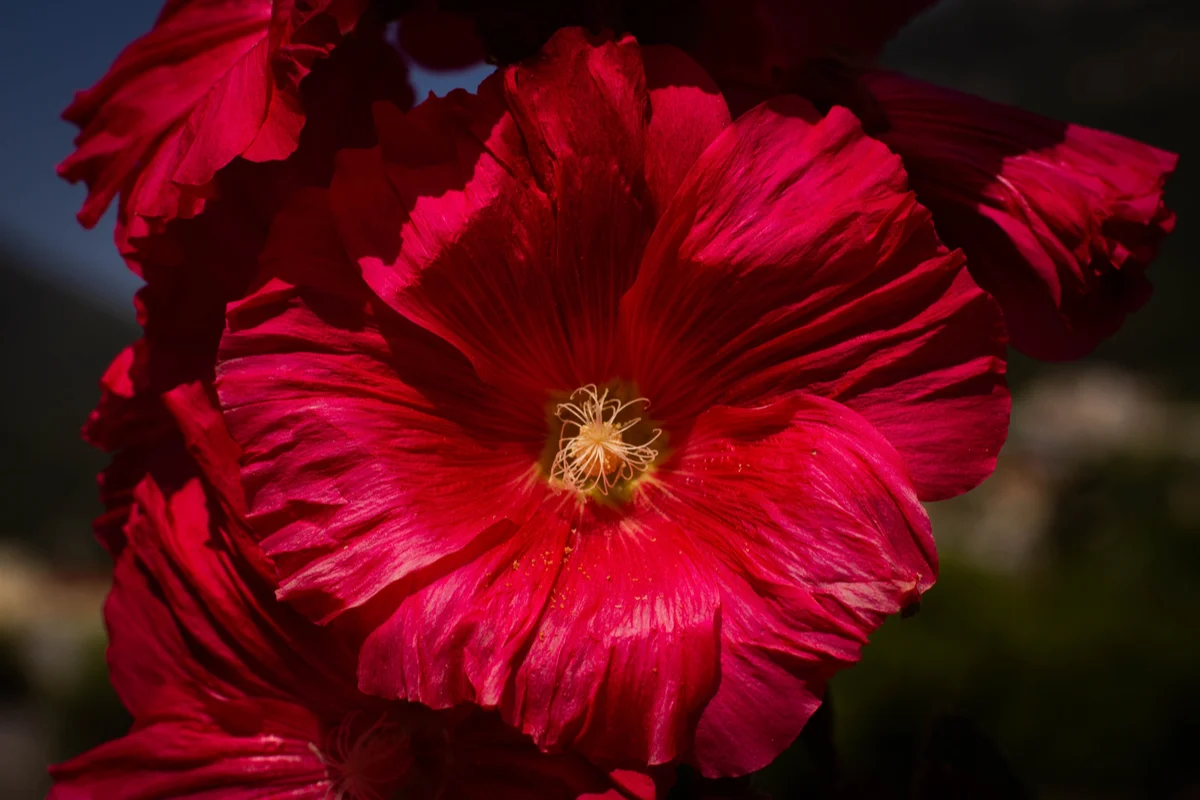
Chater’s Scarlet O’Hara double Hollyhock and Mars Magic Hollyhock are a couple of deliciously red cultivars.
Darkest of Black Hollyhocks
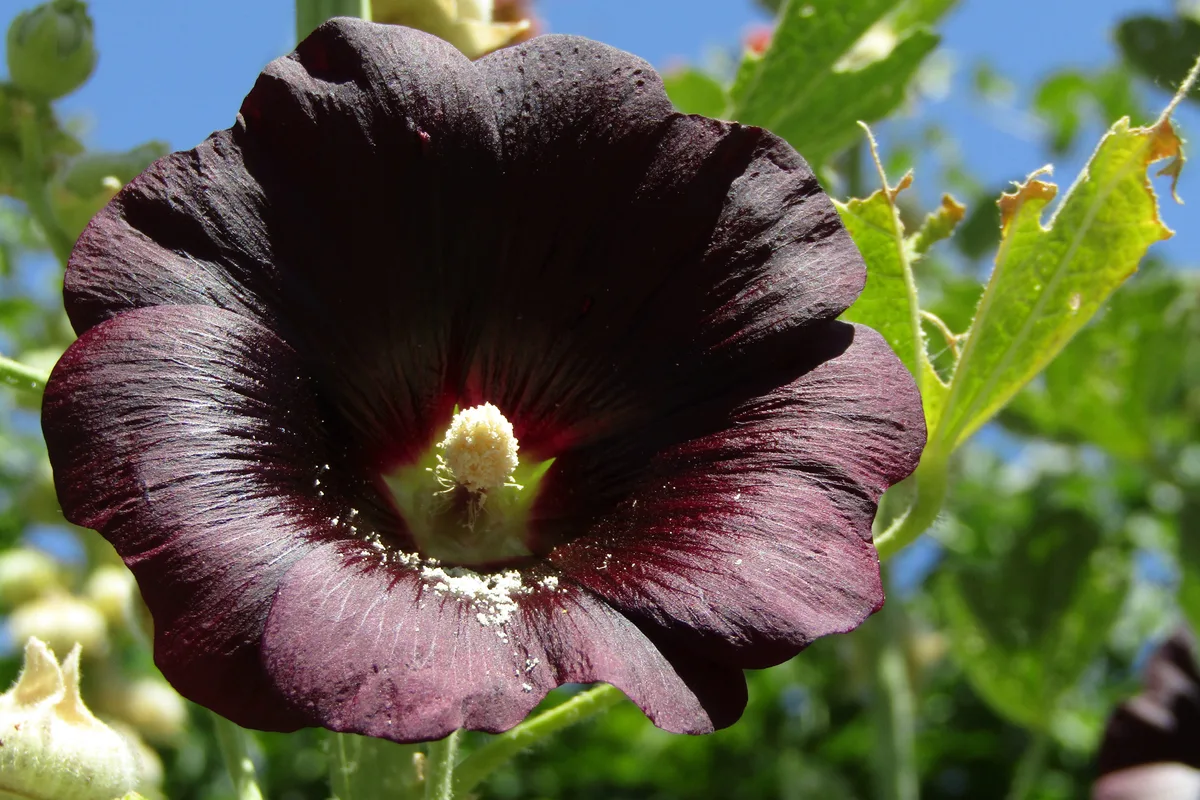
Nearly true black flowers! Black Hollyhock varieties (Alcea rosea ‘Nigra’) include ‘Jet Black’, ‘Black Watchman’, and ‘Blacknight’.
Prettiest of Pinks Hollyhocks
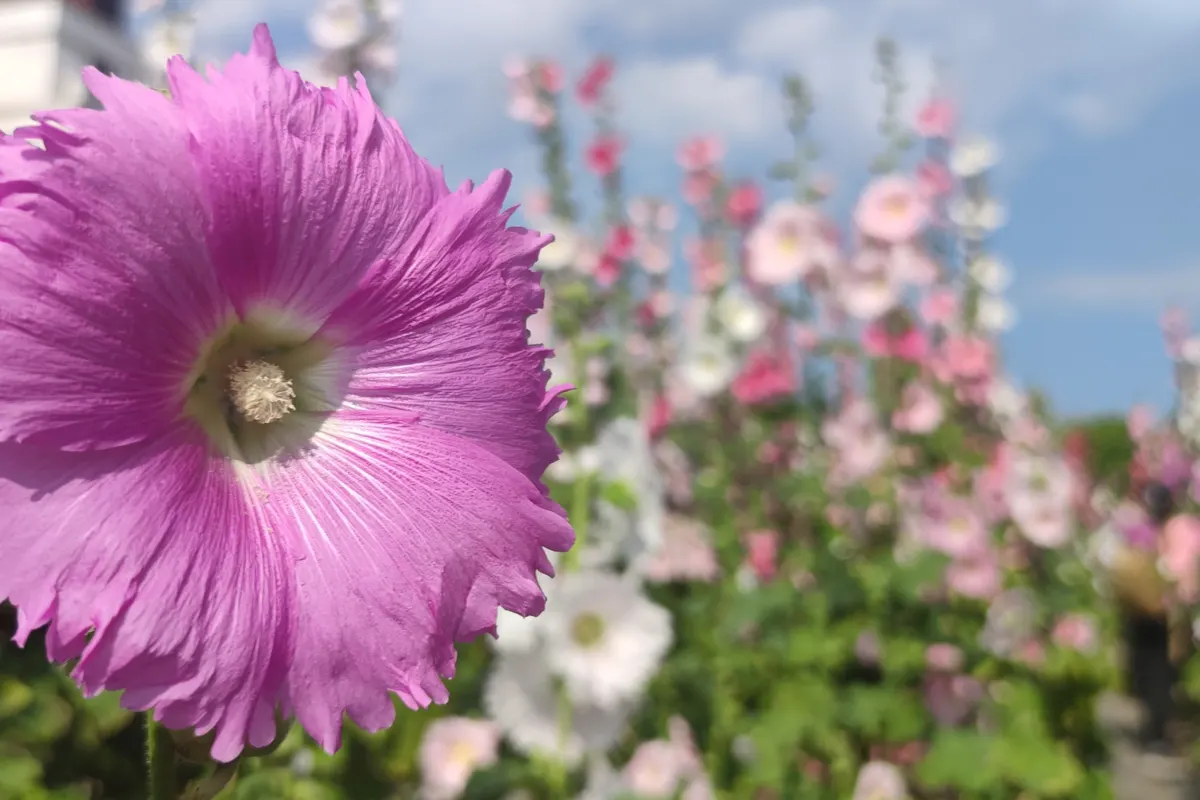
On our list of prettiest pink perennials, pink Hollyhock varieties include Radiant Rose, Halo Cerise, and Spring Celebrities Pink.
Full Moons of White Hollyhocks
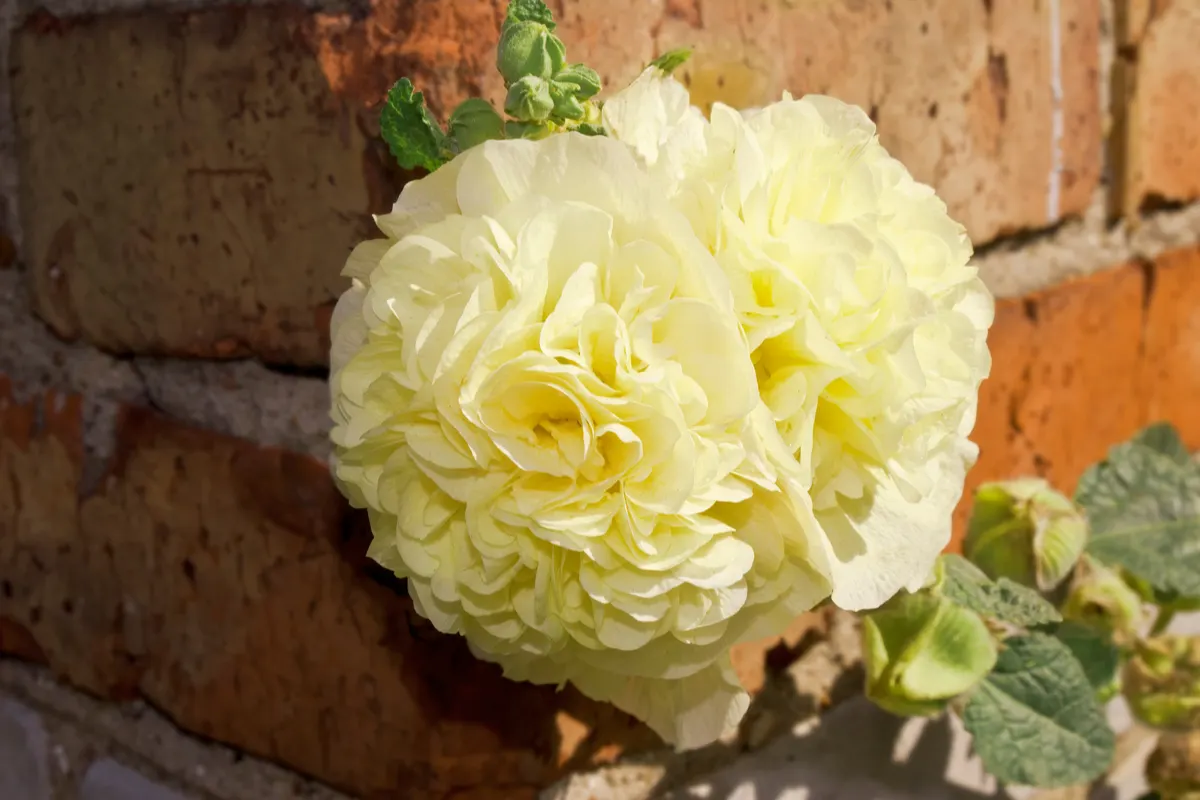
Your Moon Garden appeal will skyrocket with towers of Charter’s Icicle, Spring Celebrities White, and The Bride.
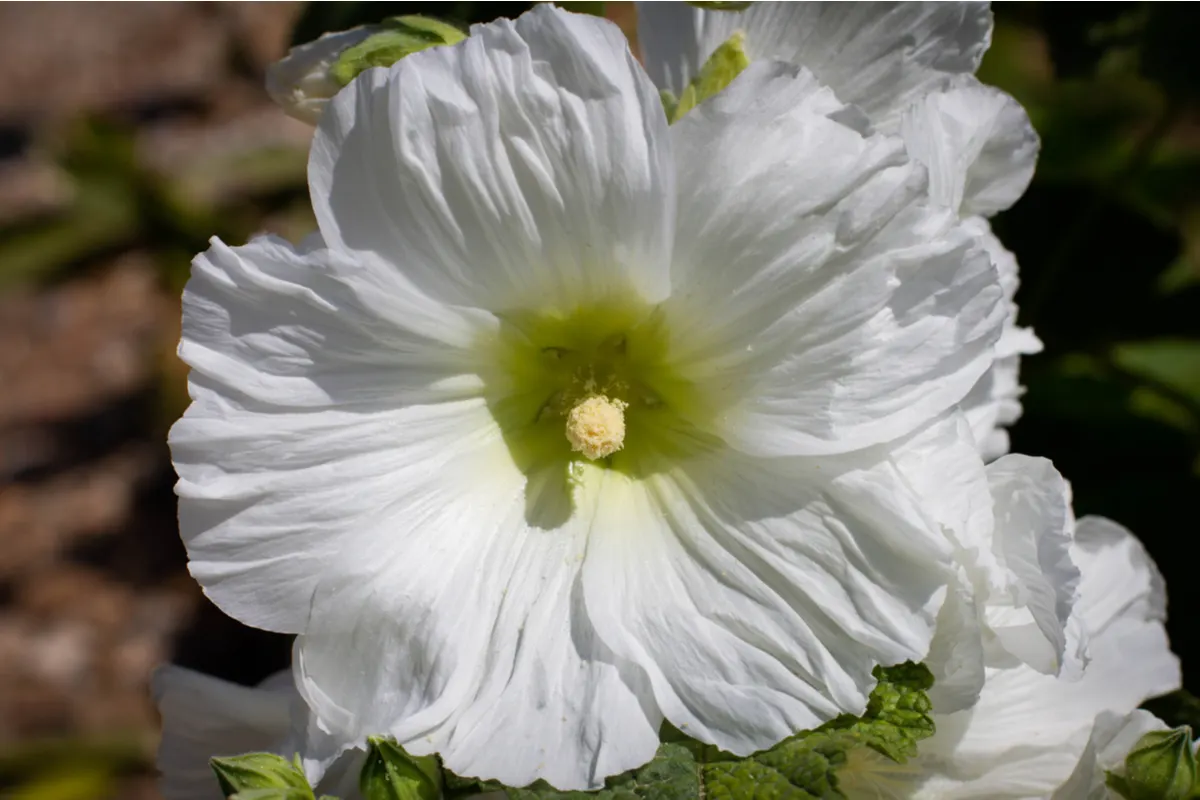
An excellent selection of Hollyhock seeds is available through Swallowtail Garden Seeds and Toadstool Seeds.
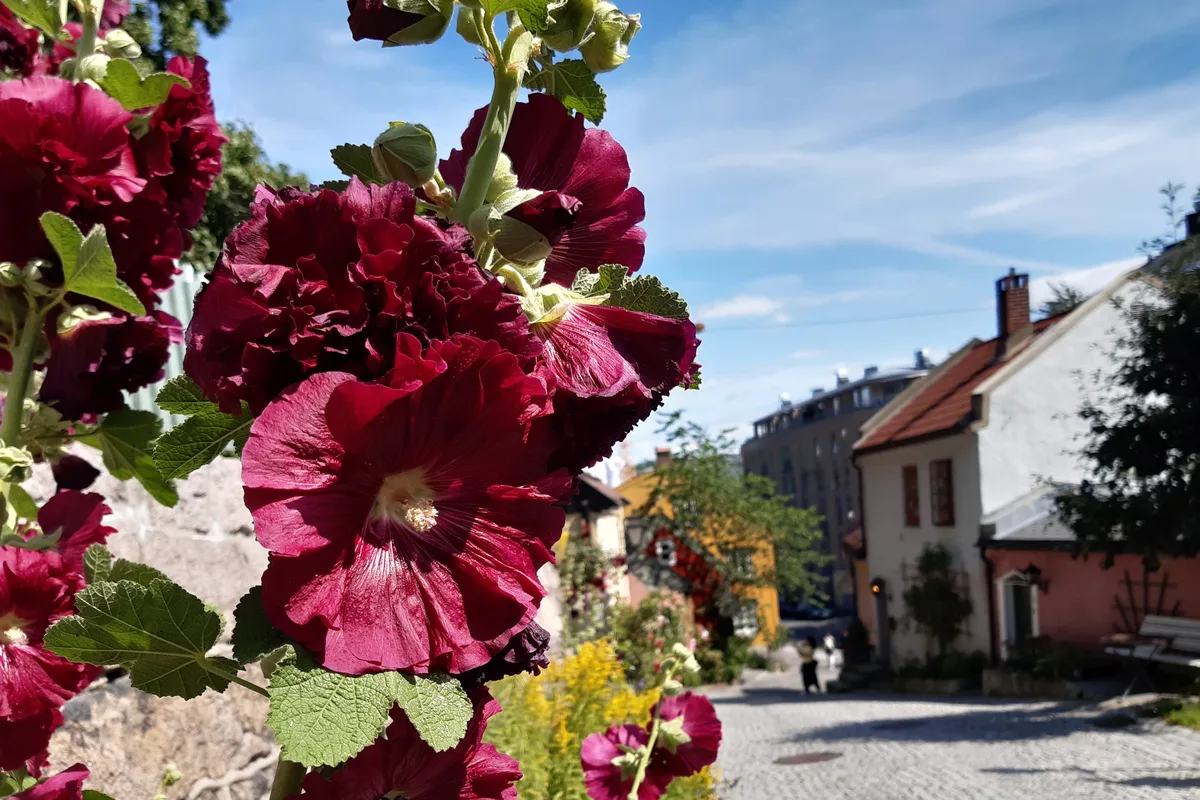
Massive petal value with dramatic towering height is among Hollyhock’s long list of virtues.
Hollyhocks are attractive to pollinators, they host and feed butterflies, and are visited by Hummingbirds for additional entertainment in the blooming backyard.
Bee balm is a great companion for Hollyhock, as are dahlia, roses, phlox, echinacea, daisies, and dianthus.
Hollyhock is related to mallows as well as hibiscus and may be used similarly in healthful teas and preparations.
Well, it is a question of to seed or not to seed.
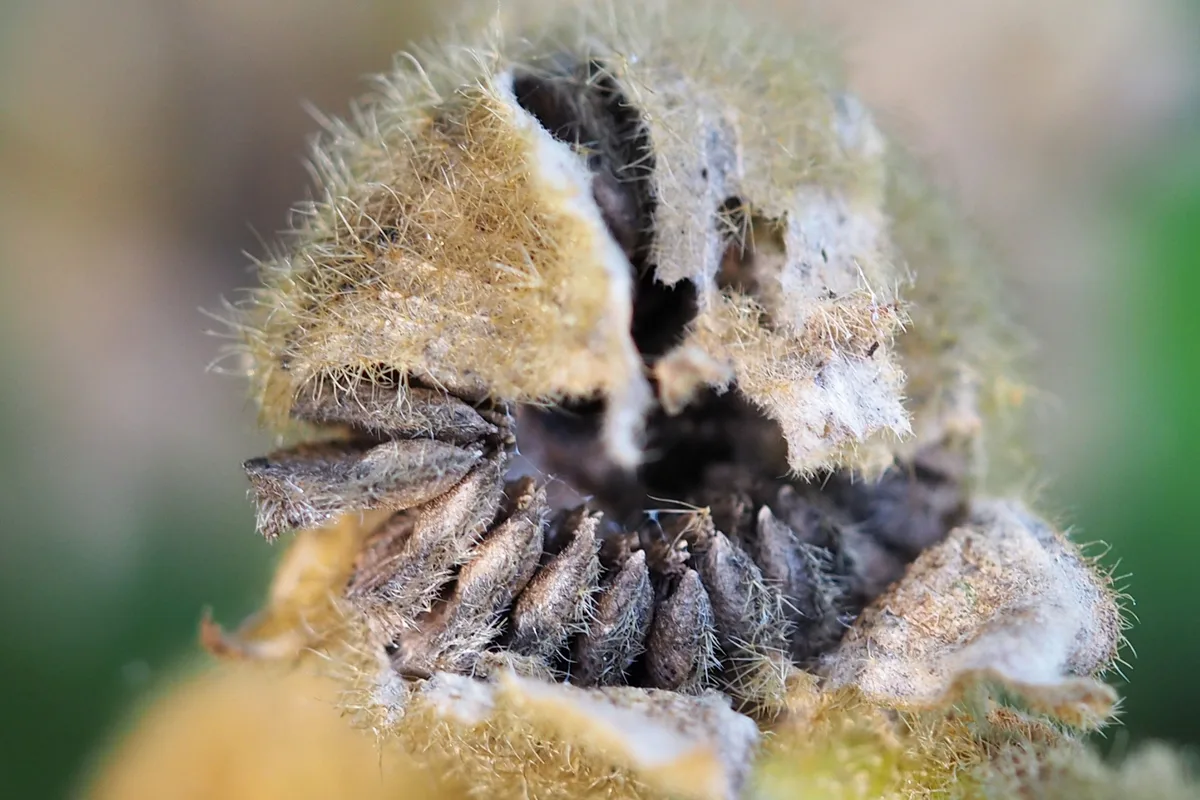
Firstly, Hollyhock flower from the bottom up. If the first flowers fade and make seeds, the plant may not open the buds all the way at the top of the stems. Pinching flowers off as they fade will encourage blooming all the way up the stalks.
But the seeds produced at the top of the plant may not grow plants as robust as the plants from seeds produced in the lower, larger flowers. Collecting seeds from the largest, and earliest flowers will promote a succession of generations of plants that grow the largest and earliest flowers. A theory; observed by me.
To deadhead is a question of your taste and whether you want the Hollyhocks to reseed themselves naturally.
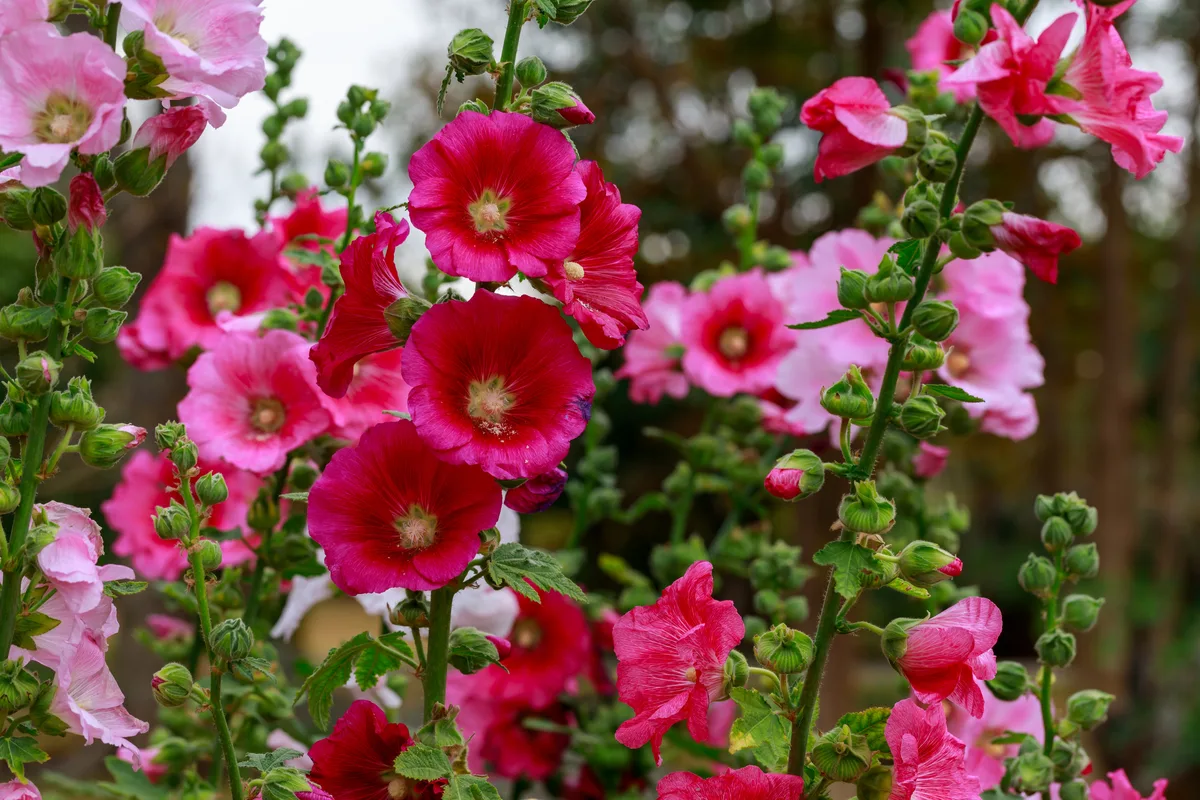
A note on growing Hollyhock in cooler climates. Plan on blooms in the second year because they need robust first-year growth in shorter growing seasons. I think this is true even for varieties that claim they will bloom in the first year.
Your first-year Hollyhock plants will benefit from a covering of mulch to protect them from fluctuating freezing temperatures during winter.
Remove mulch early in spring to prevent fungal rust diseases, particularly in soggy, wet soils.
Hollyhock will freely reseed itself in garden conditions. They rarely escape into the wild which is great if you are concerned about introducing non-native species outside of your garden.
In mild regions, you can sow seeds outdoors in late summer and fall for blooms next summer.
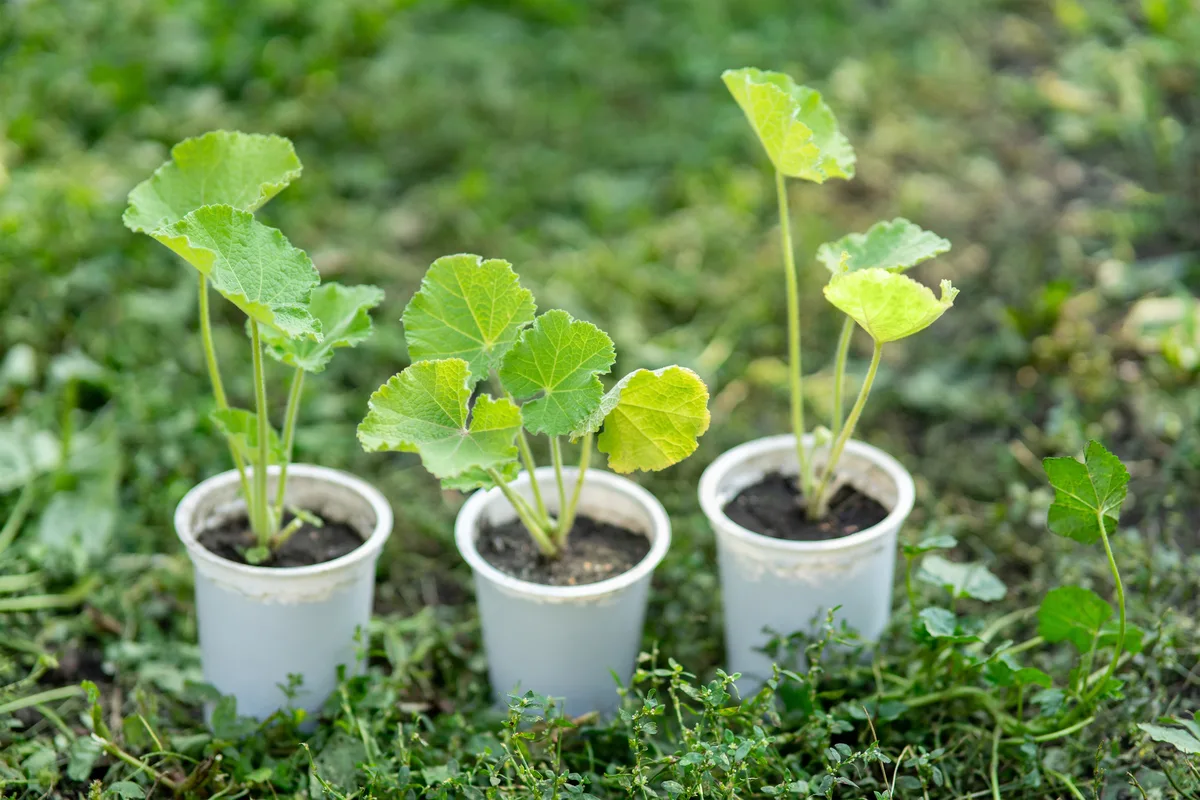
Ambitiously, you might start seeds indoors 8 to 10 weeks before the last frost date.
These early starts may bloom in the first season, or next depending on climate, weather, and cultivar of Hollyhock.

In cooler areas with shorter growing seasons, sow seeds in spring or early summer to give plants a great head start for next year’s flower show.
Germination rates are variable. For increased success, the ideal germination temperature is 60° to 70°F.
For other self-seeding plants, check out 12 Beautiful Plants That Will Self-Seed All Over Your Backyard.
Hollyhocks, as beneficial as they are beautiful, may also feed some unwelcome visitors to the garden.
Along with young butterflies, AKA caterpillars, slugs, snails, Japanese beetles, and spider mites may feast on the luscious leaves.
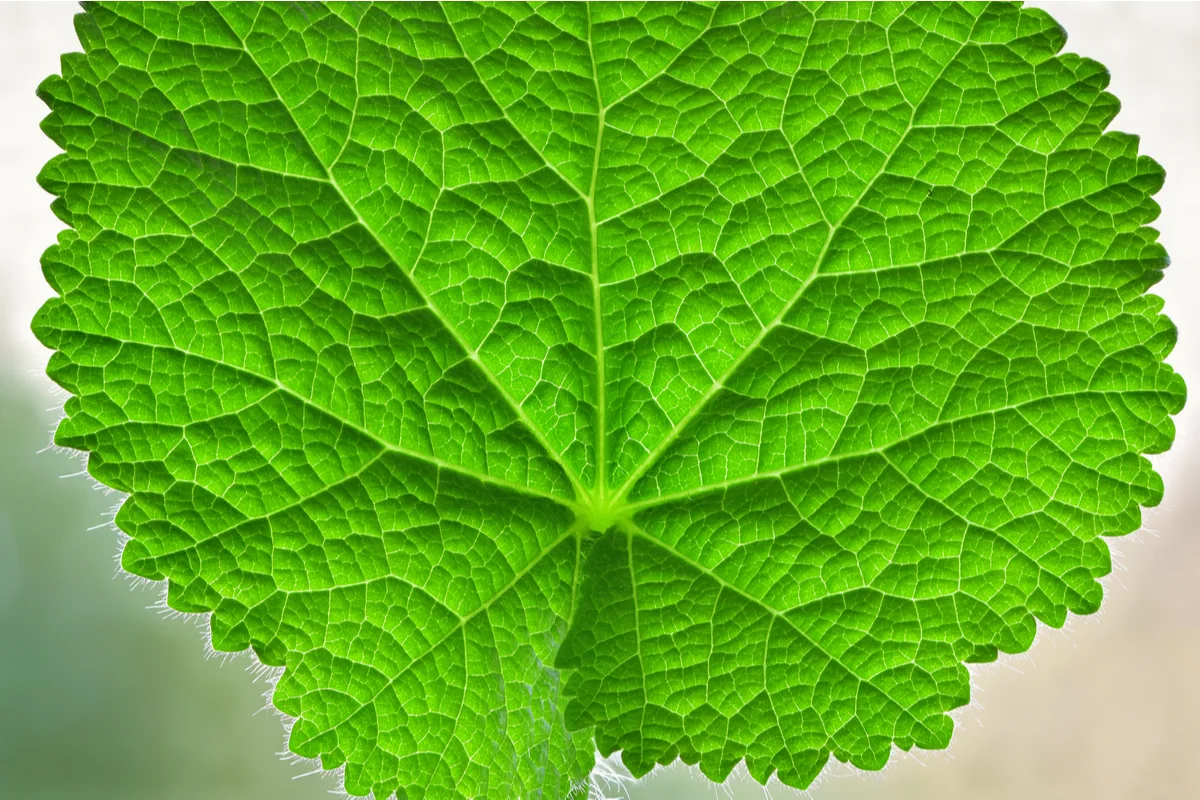
A fast-spreading, soil-borne, fungal disease known as rust may also damage, discolor, or stunt your Hollyhocks.
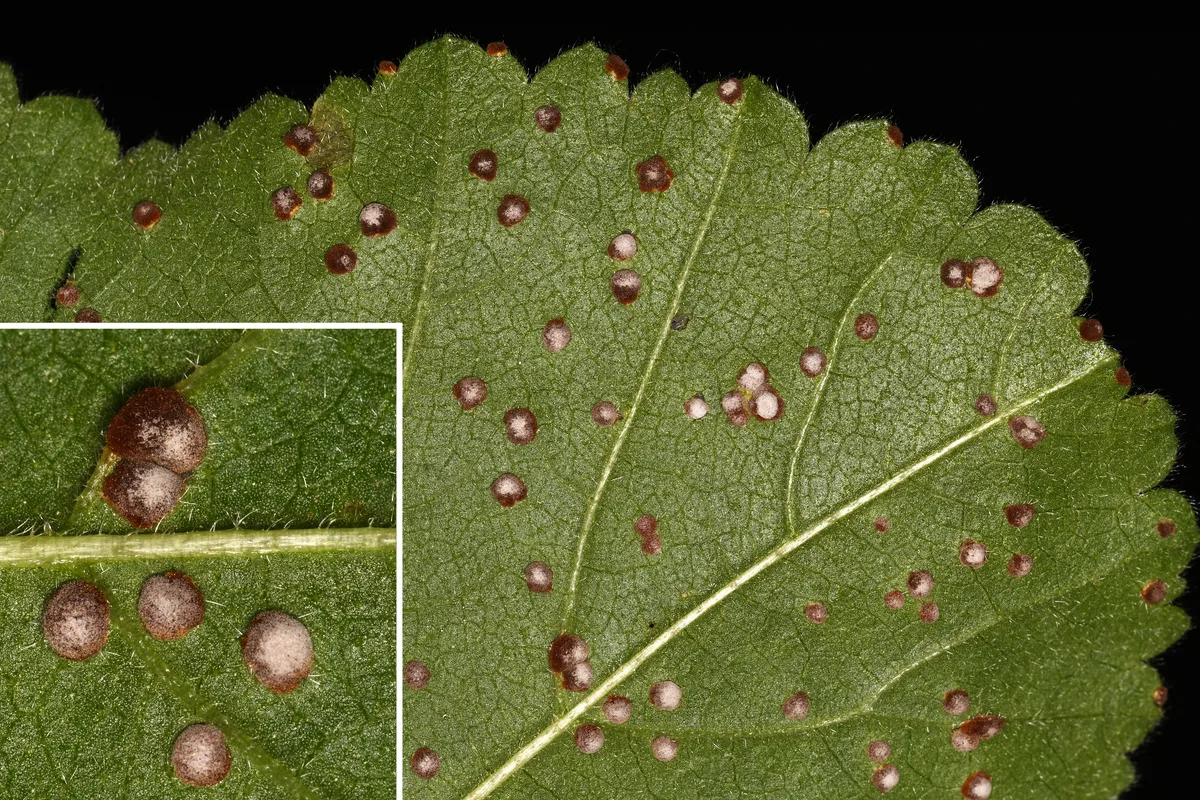
For Hollyhock pest and disease prevention:
- Water at the soil level, rather than the leaves.
- Remove insect pests like slugs and snails.
- Remove debris that may harbor insect pests and soil disease.
- Destroy diseased plant parts. The disease may survive the compost pile, so much better to destroy or remove it.
- Thin plants to 18 to 24 inches apart and ensure great air circulation.
- Provide excellent draining soil, especially in wet areas.
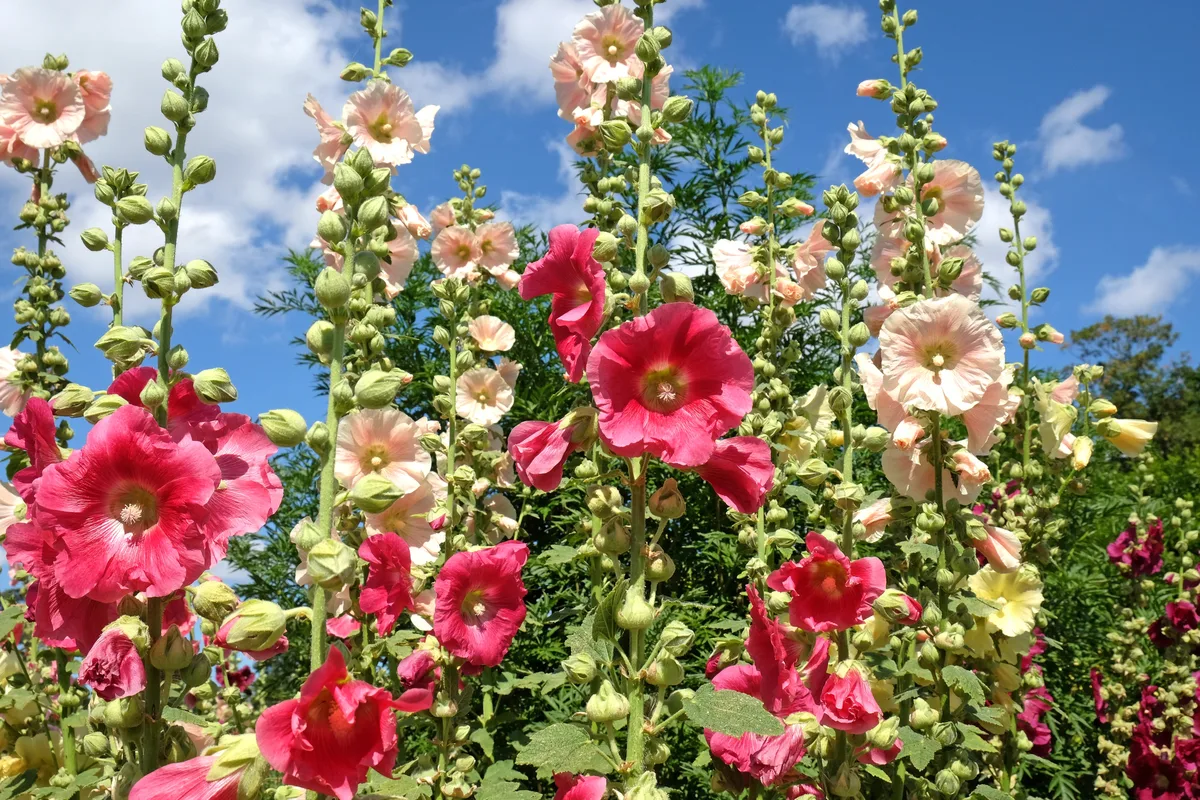
For the skyward drama of Hollyhock’s magical color spectrum, try these 10 tips to create the whimsical zeal of Heavenly Hollyhocks.


